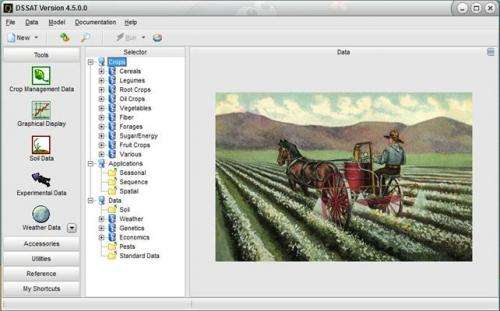Virtual farming to explore alternatives

Researchers at the Universidad Politécnica de Madrid (Technical University of Madrid) are involved in the development of a tool that, through crop simulation models, allows them to assess the integrated impact of environmental and management variables on productivity and resource conservation.
Researchers of the group AgSystems of the Universidad Politécnica de Madrid (UPM) have participated in the DSSAT which is the Decision Support System for Agrotechnology Transfer based on crop simulation models. Experts in Agro have used the DSSAT model in over 100 countries for years because it allows them to make countless virtual experiments to study alternatives not be possible another way. The upcoming release of the DSSAT v4.6 will incorporate new elements to enhance the structure and the interface of models as well as assessments and support tools.
What long-term effect would a tillage-rotation have in a crop? What about a change in crops? And what if we change both things? The options in farming are countless and its research is not feasible when using traditional methods.
In addition, the Food and Agriculture Organization of the United Nations (FAO) has estimated that we will have to double the food production in the next 40 years. Therefore, we must study alternatives based on quantitative scientific methods and we should select the best options according to the conditions of each particular place. With this purpose, a research assessed a group of models known as DSSAT. The model predictions were compared with the information of 16 years of research where the combined effect of tillage and rotations of cereal were measured. The cereal production, barley and their rotation depended exclusively on rainfall frequency.
The models captured properly the observed trends and were helpful explaining the results. The combination of conventional tillage with a cereal-legume rotation provided better results. However, the reduced tillage enhanced the soil quality compared to the conventional tillage. Those environmental aspects, which in a short-term are unnoticed, can show up thanks to those models.
A team of researchers of the School of Agricultural Engineers of the UPM has refined the calibration and the development of these models to meet the challenges also in order to use them for the specific conditions in the Spanish farming, even in environments where the water limitation for crops can be severe.
Thanks to this research, the UPM is one of the scientific institutions responsible for the development of the latest version of the DSSAT. It will incorporate new improved application programmes able to assess the financial risks and the environmental impacts related to crop models.
Provided by Universidad Politécnica de Madrid
















